Have you ever noticed mysterious stains on your ceiling or mold on your exterior walls? These could be telltale signs of a roof leak. Ignoring these signs can lead to severe and costly damage to your home. This post aims to guide you on effectively identifying and addressing these warning signs.
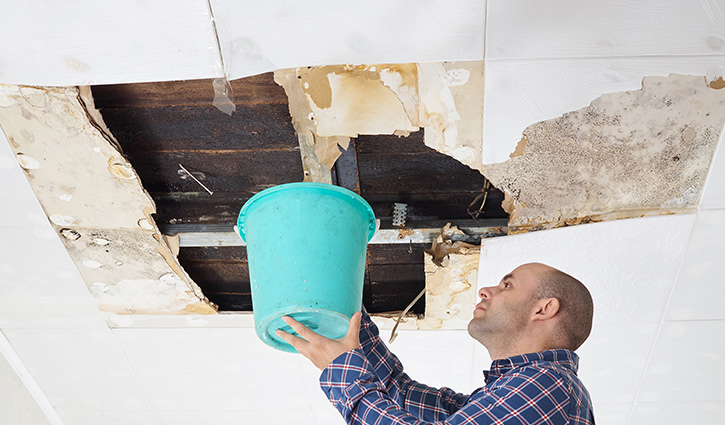
Key Roof Leak Takeaways
- Ceiling stains, ringed patterns, and mold on exterior walls are telltale signs of roof leaks.
- Professional help is necessary to identify and fix the source of a leak and repair shingle damage or faulty flashing.
- Roof maintenance and regular inspection for subtle signs in the ceiling or attic, such as water stains or musty odors, is essential.
- Assessing your roof’s age can also be beneficial when determining its susceptibility to damage.
1. Ceiling Stains
Ceiling stains, often appearing as brown rings in corners and nooks, clearly indicate a roof leak. These stains typically originate from a leaky roof and are commonly found around roof vents and overlooked areas.
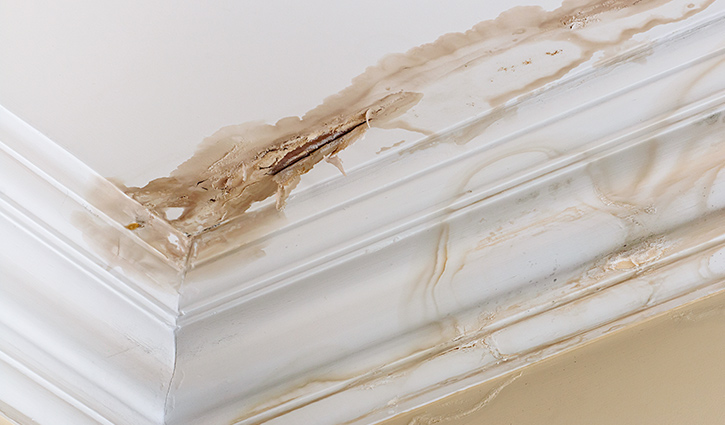
Ignoring these stains can lead to further damage, including mold growth, framing, sheathing deterioration, and ceiling impairment due to warm attic air.
The Ringed Pattern: Identifying Water Damage
The ringed pattern of water stains on ceilings is caused by water seeping through the roof due to a leak, forming a circular spread as it moves across the ceiling. These light brown rings, accompanied sometimes by musty smells, can affect the roof’s framing.
Bigger and more defined rings indicate a more serious and persistent leak, whereas smaller and vaguer rings may suggest a less severe or sporadic leak.
Action Steps for Ceiling Stains
It’s important to address ceiling stains promptly. Here are the steps to follow:
- Begin at the location of the stain and proceed upward, examining the ceiling for discoloration and signs of leaks such as water dripping or damp areas.
- After identifying the source of the leak, clean the stain with a solution of water and bleach.
- Apply a base coat of primer to the stained area.
- Replace any affected ceiling areas if necessary.
- Fill cracks and holes with sealant to prevent further damage.
By following these steps, you can effectively address and fix ceiling stains.
This will prevent future leaks and maintain the aesthetic appeal of your home.
2. Mold on Exterior Walls
Mold on exterior walls indicates moisture infiltration often due to a roof leak. Excessive mold, fungi, or moss on an exterior wall suggests moisture infiltration from roof leaks. If left unaddressed, mold and mildew can result in significant health concerns and structural deterioration, such as wood decay and interior damage.
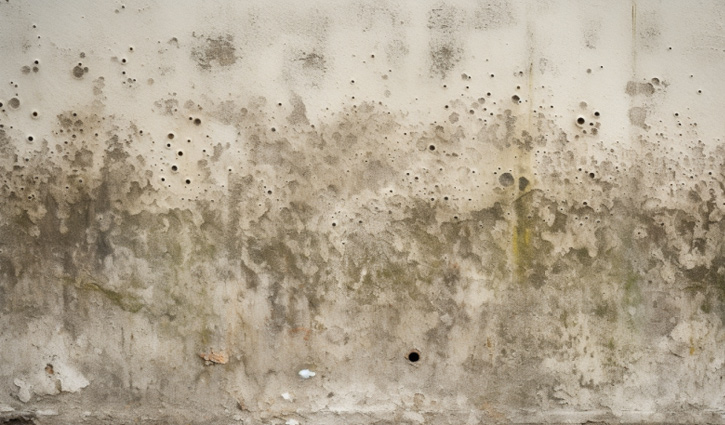
Thus, regular inspection is essential to identify mold growth early and mitigate potential structural damage and health concerns.
Locating the Leak: Tracing mold to its Source
Tracing mold spots on exterior walls to their source can help identify and fix the root cause of the leak. Indications that a roof leak is leading to mold growth on exterior walls include:
- The presence of water stains on walls and ceilings
- Signs of flashing damage
- Water dripping in the attic
- Light visible through the roof
Should you find mold on the exterior walls, promptly engage the services of a professional roofing contractor to mitigate the damage and prevent potential roof leaks.
Preventative Measures Against Mold Growth
Regular cleaning plays a significant role in preventing mold growth on exterior walls. It involves the removal of dirt, debris, and organic matter that can promote mold growth, as well as cleaning off existing mold spores. Utilizing specially formulated paints on exterior walls can aid in preventing mold growth.
In addition, maintaining a clear space between vegetation and the foundation and gutters reduces the likelihood of moisture buildup along exterior walls, mitigating the risk of mold growth.
3. Missing or Damaged Shingles
Missing or damaged shingles can lead to roof leaks and serious repercussions such as interior water damage and structural weakening. Curling or buckling shingles are typical indicators of potential damage, providing direct access to the underlayment and leading to water leakage.
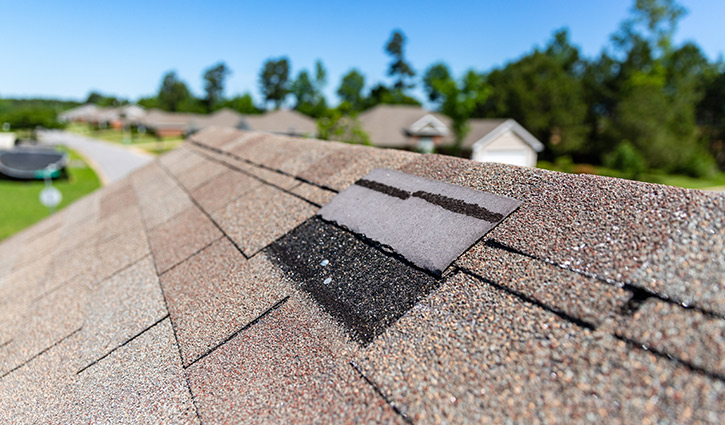
Discovering missing or damaged shingles requires assessing whether the shingles can be repaired or if a professional roofer is needed to address the damage and prevent potential roof leaks.
Spotting Shingle Issues from the Ground
To examine the roof for damaged shingles without climbing, one can observe signs of shingle damage from ground level, such as cracks, wear, or breakage. Binoculars can assist in detecting shingle issues from the ground. They enable a closer examination of the roof, facilitating the identification of loose or missing shingles without the need to climb the roof.
Promptly addressing issues identified during a ground-level roof inspection, including those related to the roof’s framing, helps to mitigate further damage.
Quick Fixes for Shingle Repair
To repair a minor roof leak in the attic, follow these steps from the roof:
- Identify the source of the leak.
- Clean the affected area.
- Apply roofing tar or bitumen paint.
- Press a shingle or patching material onto the area and secure it.
- Make sure the area is completely dry before applying the patch.
Early identification and repair of shingle damage can prevent compounding issues like water infiltration and worsening structural problems, which can lead to higher repair costs.
4. Flashing Failures
When the flashing is deteriorated and unable to function effectively, it results in roof damage that is likely to leak. The common causes for flashing damage include drying and cracking, storms, and high winds. If the flashing corrodes or becomes detached, water can seep behind the flashing and infiltrate the house, resulting in leaks.
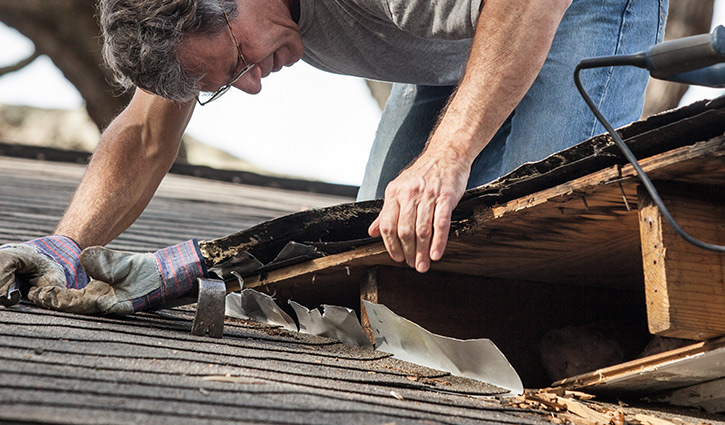
Although it’s sometimes possible to repair damaged flashing without replacing the entire roof, seeking the assistance of a professional is advised for an appropriate flashing repair.
Identifying Faulty Flashing
The function of roof flashing is to safeguard critical roof areas by diverting water from them. It is placed around roof elements such as vents, chimneys, and skylights to inhibit water from infiltrating crevices and seams, thus averting leaks and water damage.
Damaged or weakened flashing can be identified by observing signs such as cracks or rust, indicating that the flashing may no longer protect the roof from water penetration.
DIY Flashing Repairs
It’s important to avoid common mistakes when conducting DIY flashing repairs. Some of these mistakes include:
- Neglecting proper inspection
- Using the wrong materials
- Incorrectly applying sealant
- Reusing old, worn-out flashing
By avoiding these mistakes and addressing any damaged or missing flashing, you can ensure that your flashing repairs are done correctly.
5. Attic Anomalies
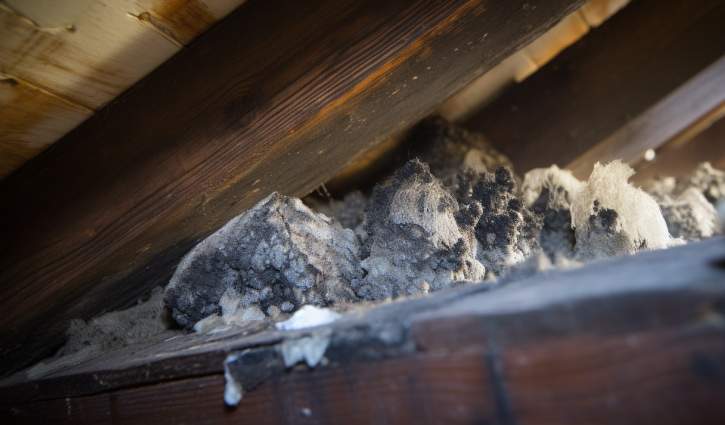
Subtle key signs of roof leaks can be found in the attic, such as water stains, mold, or damaged insulation. The attic should be first to be inspected when verifying a roof leak.
Frequent inspection is essential to proactively identify mold growth early, mitigating potential structural damage and health concerns.
Investigating the Attic Space
Indications of moisture damage in the attic include damp insulation, discoloration or water stains on rafters, walls, or ceilings, and bulging walls or ceilings associated with musty odors. For mold growth, observable signs include colored spots, black spots on the roof substrate, trusses, insulation, and surface discolorations.
It is advisable to perform attic mold testing every two years and consider employing moisture meters or infrared cameras to check for elevated moisture levels, as this helps to ensure proper ventilation that moves warm attic air and prevents mold growth.
Addressing Attic Anomalies
Finding signs of a leak in the attic calls for a professional roofer to address the damage and prevent potential roof leaks. Early identification and repair of shingle damage can prevent compounding issues like water infiltration and worsening structural problems, which can lead to higher repair costs.
Gutter Guilt: How Clogged Gutters Cause Leaks
Gutters maintain the structural integrity of a roof by directing water away from it, thus averting potential leaks. Obstructed or impaired gutters have the potential to cause water overflow, resulting in leaks.
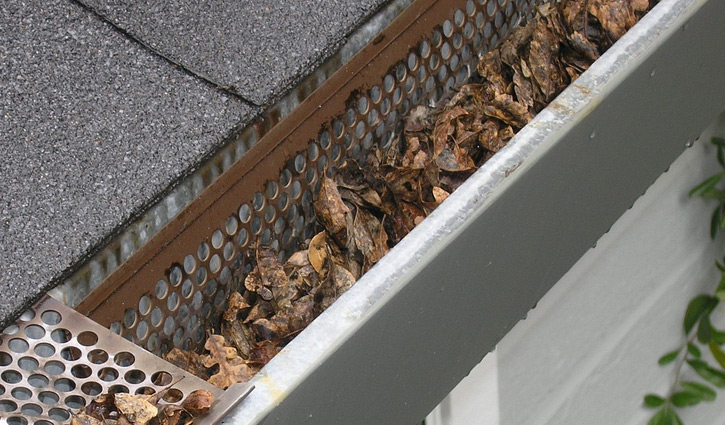
Common issues such as rusty spots, seams opening up due to expansion and contraction, or a missing gutter apron can contribute to leaks, with rusty pipes being one of the potential culprits.
Clearing Out the Clutter
It is important to regularly clean gutters of debris and clutter to ensure proper water flow and prevent leaks. Here are some signs that your gutters may be obstructed and require cleaning:
- Water overflowing from the sides or edges of the gutters
- Accumulation of water or damage to landscaping near the foundation
- Sagging, collapsing, or detachment of gutters
- Cracks or gaps in the gutters
- The presence of pests or birds in the gutters
When to Seek Gutter Professional Help
When the damage is widespread or too complex for a homeowner to address, professionals can offer a more comprehensive evaluation and guide the most suitable approach for repair or replacement.
Signs that your gutters may necessitate replacement include:
- Visible cracks, splits, or separated sections in the gutters
- Rust or peeling paint
- Sagging or detachment from the house
- Issues such as leaks, drips, or water overflowing from the gutters.
The Age Equation: Assessing Your Roof’s Lifespan
The lifespan of your roof plays a significant role in its susceptibility to leaks. The typical lifespan of an asphalt shingle roof is 15 to 20 years. As your roof ages, it becomes more susceptible to leaks and damages.
Recognizing the symptoms of an aging roof and planning for a replacement can prevent costly repairs.
Recognizing Aging Roof Symptoms
Indications of an aging roof encompass the curling or buckling of shingles and the presence of granules on the shingle surfaces. If you notice these signs, it’s important to thoroughly inspect the affected area from below for any indications of structural damage to the roof, and if deemed necessary, seek the assistance of a professional roofing expert.
Planning for Roof Replacement
Planning roof replacement before leaks can save money and protect your home from water damage. When budgeting for a roof replacement, it is advisable to:
- Obtain multiple estimates
- Research average costs
- Take material preferences into account
- Allocate funds for unforeseen expenses
- Ideally, accumulate savings over time for the project.
Summary
In conclusion, identifying and addressing signs of a roof leak early can save you from costly repairs and protect your home from further damage. Regular inspection and maintenance of your roof, attic, and gutters are essential to prevent roof leaks. If you notice any signs of a roof leak, it’s crucial to address the issue promptly and, if necessary, seek professional help.
Frequently Asked Questions
How can you tell if you have a roof leak?
Check for missing or damaged shingles, flashing or boot covers, water spots on your ceiling, and wet roof decking in your attic helps you tell whether you have a roof leak.
How long can a roof leak go unnoticed?
A minor roof leak can go undetected and unnoticed for several months, especially during a dryer weather season. Increased humidity or the smell of mildew often indicates an ongoing hidden leakage.
What do I do if the roof is leaking?
If you can identify the source of the leak, cover it with a tarp. If you can’t access the source safely, contact a roofing professional for help.
What are the typical indicators of a roof leak?
Typical indicators of a roof leak include ceiling stains, mold on exterior walls, missing or damaged shingles, and faulty flashing.
What are the signs of an aging roof?
Signs of an aging roof include the curling or buckling of shingles and granules on the surfaces.
(352) 293-2449